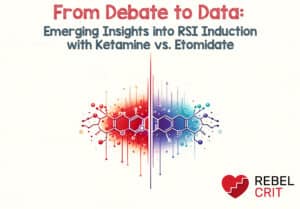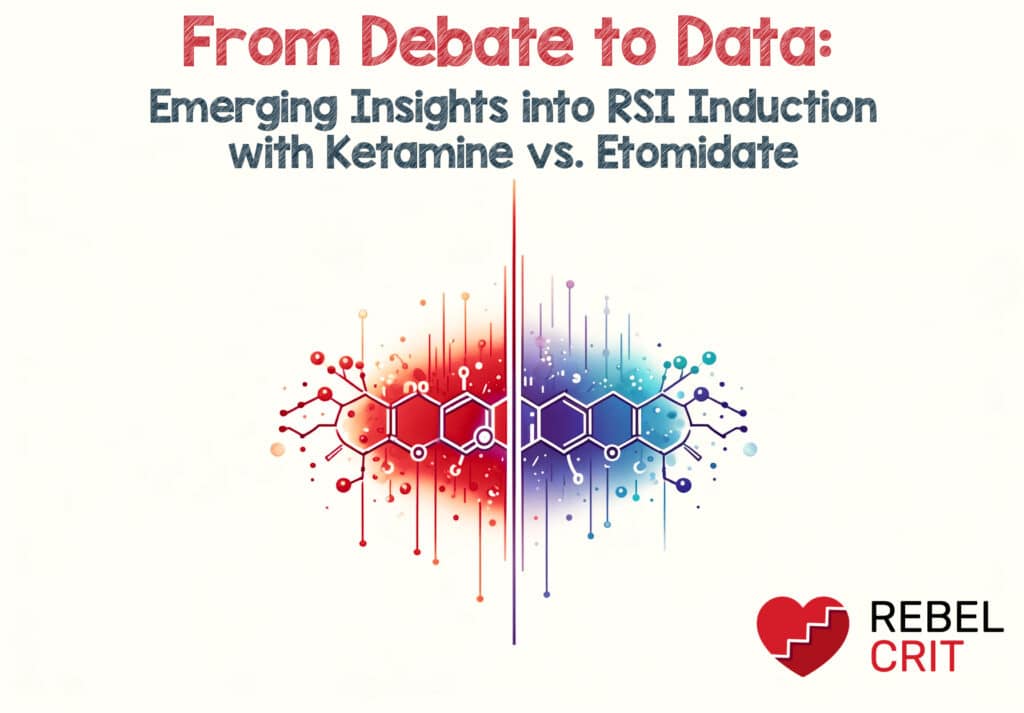
Click here for Direct Download of the Podcast
Paper: Koroki T, Kotani Y, Yaguchi T, et al. Ketamine versus etomidate as an induction agent for tracheal intubation in critically ill adults: a Bayesian meta-analysis. Crit Care. 2024;28(1):48. Published 2024 Feb 17. PMID: 38368326
Clinical Question: In adult critically ill patients requiring tracheal intubation, does ketamine, compared to any other induction agents, reduce mortality at the longest follow-up available?
What They Did:
- Systematic review and meta-analysis conducted per PRISMA guidelines.
- Two investigators searched MEDLINE, EMBASE, and the Cochrane Library for relevant randomized controlled trials from the database’s inception to April 27, 2023.
- Included patients from prehospital, emergency department, and intensive care unit.
- Assessed bias with the Cochrane risk-of-bias tool and ROBINS-I tool.
- Assessed the level of certainty in data with GRADE methodology.
- Registered at Open Science Framework (https://osf.io/2vf79/)
Population:
Inclusion Criteria:
- Randomized clinical trials and propensity-matched studies comparing ketamine versus any other agent in critically ill patients
- Critical illness: State of ill health with vital organ dysfunction and a high risk of imminent death if care is not provided.
Exclusion Criteria:
- Non-randomized trials, observational studies without matching, systematic reviews, commentaries/editorials and literature reviews, and studies not addressing review questions
Intervention:
- Ketamine as an induction agent for endotracheal intubation
Comparator:
- Any other intravenous induction agent for endotracheal intubation
Outcomes:
- Primary Outcome: All-cause mortality at the longest follow-up available
- Secondary Outcomes:
- Sequential Organ Failure Assessment (SOFA) score
- Ventilator-free days at day 28
- Vasopressor-free days at day 28
- Post-induction mean arterial pressure (MAP)
- Successful intubation on the first attempt
Results:
Article Selection:
- 2868 articles identified
- 891 duplicates removed
- 1977 articles screened
- 1922 articles excluded after title/abstract review
- 55 full-text articles were assessed for eligibility
- 47 excluded based on eligibility criteria
- 8 trials were included in the meta-analysis
- The papers included a total of 2978 critically ill adult patients
Primary and Secondary Outcomes:
- The probability that ketamine reduced mortality compared with etomidate was 83.2% (376/1475 [25%] vs. 411/1503 [27%]); RR, 0.93; 95% credible interval, (0.79–1.08)
- The probability of 1% absolute risk reduction was 62.2%
- When confining the analysis to RCTs, the probability of RR<1 was 68.6%
- The pooled data detected no statistically significant between-group differences in any secondary outcomes
Strengths:
- The authors searched multiple databases and checked for unpublished trials for potential articles.
- Used PRISMA, the Cochrane risk-of-bias tool, the ROBINS-I tool (for non-RCTs), the GRADE methodology, and registered the study, which increases the transparency and reproducibility of the meta-analysis.
- The primary outcome was patient-centered.
- Seven of eight papers were RCTs
- Seven of eight papers were rated as having a low risk of bias, and one trial was rated as having some risk.
- Statistical heterogeneity was low.
Limitations:
- The clinical question included all critically ill patients requiring intubation, resulting in a population that may be too clinically heterogeneous to pool in a meta-analysis.
- The authors did not check reference lists of included trials for additional papers.
- The authors attempted to contact the original investigators for more information but got no response.
- The authors did not specifically define the age cut-off for adult patients.
- A third senior author settled any disagreements with arbitration, but investigators did not report on the rate of agreement.
- Though authors sought trials comparing ketamine to any other induction agent, all included trials compared ketamine to etomidate.
- There is no detailed information regarding the indication for intubation (e.g., trauma, sepsis, respiratory, neuro, etc.)
- No detailed information on other interventions and medical therapies such as blood products, vasopressors, corticosteroids, antibiotics, etc.
- The authors assumed a 1% absolute risk reduction was clinically meaningful but did not supply evidence to support this assumption.
- They did not include dosing information on etomidate.
- There was some variability in the time point at which mortality was measured.
- The authors did not address between-study differences among the included trials.
- Funnel plots require a large number of studies to provide truly meaningful information.
Discussion:
The Papers:
The meta-analysis predominantly includes patients with sepsis, while other critical conditions, such as trauma, COPD, heart failure, neurologic causes, etc., are markedly underrepresented. The two largest contributing trials, conducted by Jabre 2009 and Matchett 2022, included trauma patients at relatively low rates of 22% and 7%, respectively. Furthermore, although table 1 indicates the Driver 2019 study included trauma patients requiring RSI in the ED, the trial registry (clinicaltrials.gov) suggests a more diverse cohort. Including such a varied group facilitates the search for studies to include for meta-analysis, thereby increasing the chances of finding meaningful data. However, this approach also complicates the interpretation of the data, as the resulting information becomes less directly applicable to specific clinical situations.
There were also some key differences in the time mortality was measured. For example, four of eight trials collected data on 28-day mortality, while a fifth trial collected 30-day mortality. The remaining three trials collected mortality rates at hospital discharge. Notably, the Power 2021 study focused on the hemodynamic effects of induction agents, with adverse outcomes, including mortality, assessed at 24 hours.
Do induction agents impact 28-day or 30-day mortality? It is hard to believe that a single dose of an induction agent would impact all-cause mortality in one month. Their short half-life would intuitively suggest a short-term impact. Perhaps 24- or 48-hour morbidity/mortality is a more reasonable outcome. Nonetheless, the variation in the timing of outcome measurement in the included trials raises questions about the relevance and utility of incorporating short-term outcomes into the meta-analysis juxtaposed with other trials with far longer measurements.
Statistical, Methodological, and Clinical Heterogeneity:
Statistical heterogeneity in meta-analysis refers to the variability in study outcomes that cannot be attributed to chance alone (Murad 2014). In this study, statistical heterogeneity was relatively low in both the Bayesian analysis (Heterogeneity: τ = 0.091 [0.016-0.227]) and the frequentist analysis, which included only RCTs (Heterogeneity: Tau2 = 0.00; Chi2 = 7.04, df = 6 (P = 0.32); I2 = 15%).
Methodological heterogeneity refers to variations in the design and quality of studies included in a meta-analysis. Seven of eight trials were RCTs, seven of eight were rated as low risk of bias, and one RCT had some concern for bias. While there was little methodologic variation in this study, including papers with weak methodologies may bias the overall findings of any meta-analysis. (Tufanaru 2015)
Clinical heterogeneity, where studies may be conceptually similar but differ clinically, can limit the usefulness of a meta-analysis. This clinical variability is apparent when a clear difference in the pathophysiologic basis for disease exists. For instance, the mechanisms necessitating intubation in patients with trauma, septic shock, and COPD are drastically different. Combining clinically heterogeneous trials to obtain a point estimate on mortality rate, regardless of the disease process, may be inappropriate, highlighting the need for cautious interpretation.
Authors should attempt to explain clinical heterogeneity in data with subgroup analysis to help identify areas where patients could respond differently to comparable interventions. (Gagnier 2012) While the authors performed a subgroup analysis on only RCTs (7 trials) and another eliminating trials with a high risk of bias (0 trials), additional subgroup analysis on the diagnosis or reason for intubation might provide vital hypothesis-generating data.
Bayesian Approach:
The Bayesian methodology is commonly used to guide the interpretation of diagnostic testing. Accurately determining the likelihood of a positively tested patient having a disease requires consideration of both the test’s accuracy and the disease prevalence in the population. For example, even with a 99% test accuracy, if the disease is rare, occurring only in 1 out of 10,000, the probability of a positively tested patient truly having the disease is less than 1%. This underscores how prior beliefs in Bayesian inference strongly affect the final conclusions by updating them with new test results.
Researchers can apply the Bayesian approach beyond diagnostic testing, as seen in this meta-analysis. Frequentist statistics, using confidence intervals and P values, require either acceptance or rejection of the null hypothesis based on measured data. Instead, Bayesian statistics answer the question: “What is the probability of the hypothesis given the measured data?” (Hackenberger 2019).
Frequentist statistics can be helpful when there is little or no uncertainty and a clear answer—like chess. However, physicians regularly make clinical decisions when information is hidden or incomplete—like poker. Presenting data in terms of probabilities is clinically useful for bedside management especially when dealing with complex systems and high degrees of uncertainty. With a posterior probability of 83.2% that ketamine is superior to etomidate, some would argue that additional studies are unnecessary and resuscitationists should embrace ketamine.
Author’s Conclusion: “This meta-analysis identified seven randomized trials and one propensity-matched study which assessed ketamine as an induction agent compared to etomidate among critically ill adults requiring tracheal intubation. We found a moderate probability that induction with ketamine, compared to etomidate, was associated with a reduced risk of mortality. Further research is required to determine the potential beneficial effects of ketamine on clinically relevant outcomes.”
Our Conclusion:
Finding a statistically significant mortality benefit based on a single treatment in all critically ill patients is extremely difficult and would require an enormous sample size. This meta-analysis provides interesting data with a moderate probability that ketamine reduces mortality compared to etomidate. However, the broad inclusion of a clinically heterogeneous population raises some concerns about the applicability of the resulting data to ALL critically ill patients.
Clinical Bottom Line:
This meta-analysis suggests that ketamine may be a better agent in most clinical situations than etomidate. However, making a blanket statement with such a heterogeneous population and limited sub-group analysis is difficult. Large, international, multicenter, randomized clinical trials are needed to help discern which subsets of patients may benefit from induction with ketamine vs etomidate. The debate continues…
Check out these Additional FOAMEd Resources:
- The Bottom Line: KETASED: Etomidate versus ketamine for rapid sequence intubation in acutely ill patients: a multicentre randomised controlled trial.
- EMRA: Critical Care Alert: The EvK Clinical Trial: Etomidate vs. Ketamine For Emergency Endotracheal Intubation
- REBEL EM: The EvK Trial: Ketamine vs Etomidate for Rapid Sequence Intubation
References:
- Koroki T, Kotani Y, Yaguchi T, et al. Ketamine versus etomidate as an induction agent for tracheal intubation in critically ill adults: a Bayesian meta-analysis. Crit Care. 2024;28(1):48. Published 2024 Feb 17. PMID: 38368326
- Albert SG, Ariyan S, Rather A. The effect of etomidate on adrenal function in critical illness: a systematic review. Intensive Care Med. 2011;37(6):901-910. PMID: 21373823
- Mohr NM, Pape SG, Runde D, Kaji AH, Walls RM, Brown CA 3rd. Etomidate Use Is Associated With Less Hypotension Than Ketamine for Emergency Department Sepsis Intubations: A NEAR Cohort Study. Acad Emerg Med. 2020;27(11):1140-1149. PMID: 32602974
- Jabre P, Combes X, Lapostolle F, et al. Etomidate versus ketamine for rapid sequence intubation in acutely ill patients: a multicentre randomised controlled trial. Lancet. 2009;374(9686):293-300. PMID: 19573904
- Matchett G, Gasanova I, Riccio CA, et al. Etomidate versus ketamine for emergency endotracheal intubation: a randomized clinical trial. Intensive Care Med. 2022;48(1):78-91. PMID: 34904190
- Driver Ketamine Versus Etomidate for Rapid Sequence Intubation [Internet]. 2019 [cited 2023 Aug 13]. Available from: https://classic.clinicaltrials.gov/ct2/show/study/NCT01823328
- Powers WF. Evaluating the Hemodynamic Effects of Ketamine Versus Etomidate During Rapid Sequence Intubation (Ket-RSI) [Internet]. 2021. Available from: https://clinicaltrials.gov/ct2/show/study/NCT03545503
- Murad MH, Montori VM, Ioannidis JP, et al. How to read a systematic review and meta-analysis and apply the results to patient care: users’ guides to the medical literature. JAMA. 2014;312(2):171-179. PMID: 25005654
- Tufanaru C, Munn Z, Stephenson M, Aromataris E. Fixed or random effects meta-analysis? Common methodological issues in systematic reviews of effectiveness. Int J Evid Based Healthc. 2015;13(3):196-207. PMID: 26355603
- Gagnier JJ, Moher D, Boon H, Beyene J, Bombardier C. Investigating clinical heterogeneity in systematic reviews: a methodologic review of guidance in the literature. BMC Med Res Methodol. 2012;12:111. Published 2012 Jul 30. PMID: 22846171
- Hackenberger BK. Bayes or not Bayes, is this the question?. Croat Med J. 2019;60(1):50-52. PMID: 30825279
Post Peer Reviewed By: Salim R. Rezaie, MD (Twitter/X: @srrezaie) and Anand Swaminathan, MD (Twiiter/X: @EMSwami)




